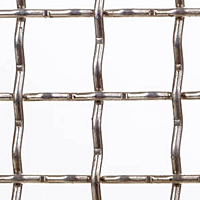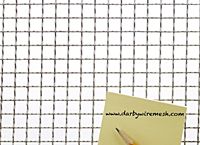
PO BOX 50049
Philadelphia, PA 19132
Phone: 215-236-2203 • Fax: 215-236-9989
Email: [email protected]
Website: www.darbywire.b2bdd.net


| Items |
 2AL.080IN Aluminum Wire Mesh - 2 x 2 Mesh, 0.080" Diameter Wire |
 2AL.063IN Aluminum Wire Mesh - 2 x 2 Mesh, 0.063" Diameter Wire |
||
| Material | N/A Aluminum | |||
| Mesh | N/A 2 | |||
| Wire Diameter | N/A 0.080 in | N/A 0.063 in | ||
| Width of Opening | N/A 0.420 in | N/A 0.437 in | ||
| Weave/Crimp Type | N/A Intercrimp/Lock | |||
| % of Open Area | N/A 70.56 % | N/A 76.39 % | ||
| Weight | N/A 0.276 lb/ft² | N/A 0.171 lb/ft² | ||
| Silicon (Si) - Alloy 1350 | N/A 0.10 % | |||
| Iron (Fe) - Alloy 1350 | N/A 0.40 % | |||
| Copper (Cu) - Alloy 1350 | N/A 0.05 % | |||
| Manganese (Mn) - Alloy 1350 | N/A 0.01 % | |||
| Chromium (Cr) - Alloy 1350 | N/A 0.01 % | |||
| Zinc (Zn) - Alloy 1350 | N/A 0.05 % | |||
| Gallium (Ga) - Alloy 1350 | N/A 0.03 % | |||
| Other - Alloy 1350 | N/A Trace | |||
| Aluminum - Alloy 1350 | N/A 99.50 % | |||
| Silicon (Si) - Alloy 5052 | N/A 0.25 % | |||
| Iron (Fe) - Alloy 5052 | N/A 0.40 % | |||
| Copper (Cu) - Alloy 5052 | N/A 0.10 % | |||
| Manganese (Mn) - Alloy 5052 | N/A 0.10 % | |||
| Magnesium (Mg) - Alloy 5052 | N/A 2.2 to 2.8 % | |||
| Chromium (Cr) - Alloy 5052 | N/A 0.15 to 0.35 % | |||
| Zinc (Zn) - Alloy 5052 | N/A 0.10 % | |||
| Aluminum - Alloy 5052 | N/A Remainder | |||
| Silicon (Si) - Alloy 5056 | N/A 0.3 % | |||
| Iron (Fe) - Alloy 5056 | N/A 0.40 % | |||
| Copper (Cu) - Alloy 5056 | N/A 0.1 % | |||
| Manganese (Mn) - Alloy 5056 | N/A 0.05 to 0.20 % | |||
| Magnesium (Mg) - Alloy 5056 | N/A 4.5 to 5.6 % | |||
| Chromium (Cr) - Alloy 5056 | N/A 0.05 to 0.20 % | |||
| Zinc (Zn) - Alloy 5056 | N/A 0.10 % | |||
| Aluminum - Alloy 5056 | N/A Remainder | |||
| Silicon (Si) - Alloy 6061 | N/A 0.40 to 0.8 % | |||
| Iron (Fe) - Alloy 6061 | N/A 0.70 % | |||
| Copper (Cu) - Alloy 6061 | N/A 0.15 to 0.40 % | |||
| Manganese (Mn) - Alloy 6061 | N/A 0.15 % | |||
| Magnesium (Mg) - Alloy 6061 | N/A 0.8 to 1.2 % | |||
| Chromium (Cr) - Alloy 6061 | N/A 0.04 to 0.35 % | |||
| Zinc (Zn) - Alloy 6061 | N/A 0.25 % | |||
| Titanium (Ti) - Alloy 6061 | N/A 0.15 % | |||
| Aluminum - Alloy 6061 | N/A Remainder | |||
| Additional Information |
N/A
Aluminum is largely considered the most popular non-ferrous metal in the world, and as such, aluminum alloys are commonly used in the wire mesh industry. Aluminum alloys are composed primarily of aluminum, and also contain other elements like copper, magnesium, manganese, or silicon. Aluminum woven wire mesh is lightweight; in fact, a good rule of thumb is that, when compared to its stainless steel counterpart, aluminum mesh is approximately 1/3rd the weight of stainless. Aluminum wire mesh is also corrosion resistant in most normal environments but will corrode quickly in the presence of alkaline solutions and hydrochloric and hydrofluoric acids. With an estimated melting point of 1218oF, aluminum has many benefits, including a relatively low cost compared to other meshes. Aluminum woven wire mesh is a popular choice for a wide array of industries including aerospace and automotive, as well as marine and electrical conductivity applications. The items listed on this website represent many of the most requested specifications of aluminum woven wire mesh. These items are available from stock or can be custom manufactured. Should you not see your preferred specification, please contact us to discuss your requirements. |
|||
| Popular Industries and Applications | N/A Aerospace Agricultural Architectural Automotive Bird Screen Building & Construction Filtration & Separation Food Infill Panels Marine Industries Pest & Critter Control Ventilation | |||
|
|
||||